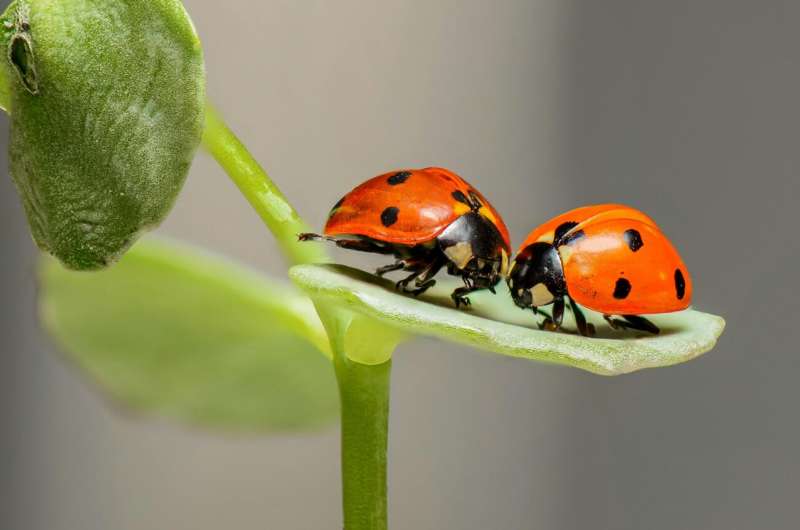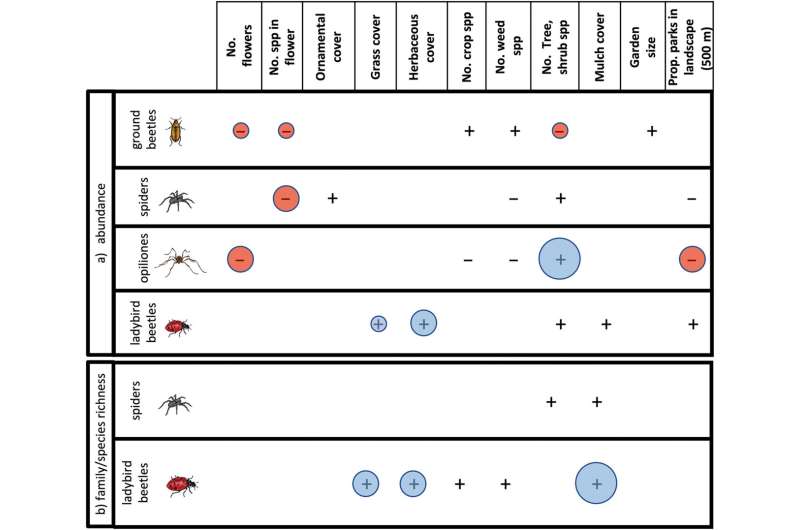This article has been reviewed according to Science X's editorial process and policies. Editors have highlighted the following attributes while ensuring the content's credibility:
fact-checked
peer-reviewed publication
trusted source
proofread
Ladybugs: Understanding the beneficial predators among us

Lady beetles, also known as ladybugs, are distinct, varied and abundant, with approximately 500 species in North America and 6,000 worldwide. Their oval, dome-shaped bodies can be colorful and decorative, but the "lady" designation has nothing to do with their appearance.
According to National Geographic, European farmers in the Middle Ages called these helpful insects "Beetles of Our Lady," a reference to the Virgin Mary to whom they prayed for good crops. Lady beetles are superheroes to farmers and gardeners because they devour potentially destructive pests.
"For decades, researchers in my field have been looking at the diversity of these beneficial insects," says Heidi Liere, assistant professor of biology. "We often get the question, 'Are non-native species as beneficial as native species?'"
Liere is a community insect ecologist who is currently studying interactions between native species and non-native species of lady beetles in the Portland area. She is also an expert in the field of agroecology, which applies ecological concepts to agriculture with an eye toward sustainable farming that works with nature. Liere's research is focused on understanding the links between biodiversity and ecosystem function and benefits.
Conservation of lady beetles is thought to be key to effective natural pest control, since they keep herbivore populations below damaging levels in agroecosystems. preserving biodiversity, largely because these crop-saving insects prevent disruption within an ecosystem. Lady beetles may also be bioindicators of climate change due to their sensitivity to climatic and resource changes.
"We are looking at how the different species of beetles compete for resources," says Liere. "There is lots of evidence that the presence of non-native species affects the native species, but we wanted to take a closer look at how these interactions will be impacted by a changing climate. Will the effects of non-native species on native species be dampened or exacerbated by climate change?"
Survival of the fittest lady beetle
In Liere's lab, this "closer look" can be quite literal.
This summer, two students, Jackson Gamby BA '24 and Mairin Thorne BA '24, are working in Liere's lab as part of the John S. Rogers Science Research Program. The program supports undergraduate students in collaborative scientific research with faculty over the summer, an opportunity to gain valuable hands-on experience.
Liere, Gamby, and Thorne have been acquiring non-native lady beetle species, as well as aphids (which they feed on), during collecting trips to Portland-area urban farms and gardens, including Zenger Farm, Black Futures Farm, and Tryon Life Community Farm.
Back at the lab, Gamby and Thorne run their experiments by placing the lady beetles in a petri dish under a microscope. A video camera captures the lady beetle behaviors and interactions.
The team watches the livestream on the computer screen, sometimes for hours at a time. This gives Liere and the students the chance to observe the lady beetles in action. Sometimes the beetles are placed in head-to-head competition for food.

"We record when they are cleaning themselves, when they are stealing each other's food," says Liere. "Don't be fooled by their beauty! They can be vicious. The aphids we collect are sometimes the same size as them, and the beetles eat them."
For this summer's research project, Gamby and Thorne, both biology majors, are looking to record the number of competitive interactions between native and non-native species of lady beetles; determine how these interspecies interactions affect aphid consumption rates; explore species diversity and distribution in the Portland Metro Area; and determine how these interactions might change at different temperatures.
Gamby says it's her first lab experience, and it has been really valuable for her.
"I'm not totally sure what I want to do after Lewis & Clark, but this is definitely helping me narrow it down," says Gamby. "I feel like I'm a lot closer to figuring it out. than I was before I started doing this program."
Right now, the research team is focused on conducting experiments at room temperature. Their next steps are to conduct them at a higher temperature, one that might represent a hot Portland summer.
"Lady beetles might be canaries in the coalmine, due to their sensitivity to climatic and trophic changes," said Thorne during a recent presentation, part of the Rogers Tuesday Talks. "Climate change will change the habitat by pushing the thermal limit. It may also affect food sources. So one question we have is, 'Could this exacerbate invasive species effects?'"
Thorne says it is even possible that an invasive species might be able to withstand the harsher conditions created by climate change better than native species.
Urban Garden Ecology project
Before joining the faculty of the biology department at Lewis & Clark, Liere taught and conducted her research in the Seattle area. In the summer of 2019, she and her colleagues collected predators; vegetation; ground cover; and garden and landscape data from 10 community gardens in the city of Seattle.
They found that different groups of natural enemies are associated with different environmental variables and at different scales; these findings likely reflect differences in their dispersal capabilities, habits, and diets. The results were published in an article titled "Local and landscape factors differentially influence predatory arthropods in urban agroecosystems" in the journal Ecosphere.
In addition to her work at Lewis & Clark, Liere codirects the Urban Garden Ecology project, based on the central California coast at the University of California at Santa Cruz. The research group investigates the ecological interactions and processes in urban gardens that provide ecosystem services like pollination, pest control, and climate regulation. Their aim is to increase scientific understanding of urban garden ecology and improve urban agricultural sustainability for people and the environment.
"As a growing percentage of the global landscape continues to urbanize," explains Liere, "it becomes more and more important to understand the ecology of urban green spaces and their ecosystems."
More information: Heidi Liere et al, Local and landscape factors differentially influence predatory arthropods in urban agroecosystems, Ecosphere (2024). DOI: 10.1002/ecs2.4816
Journal information: Ecosphere
Provided by Lewis & Clark College




















